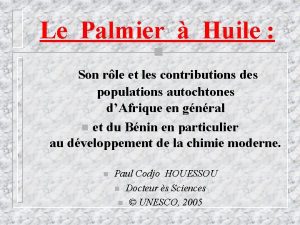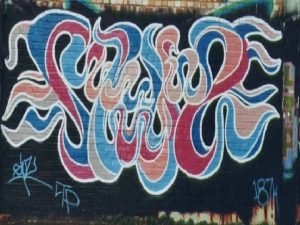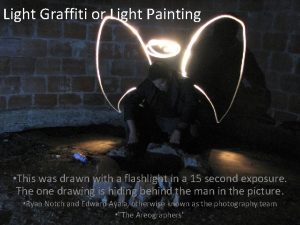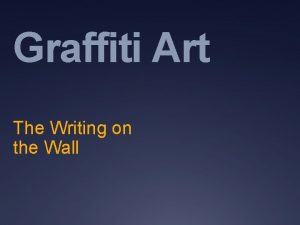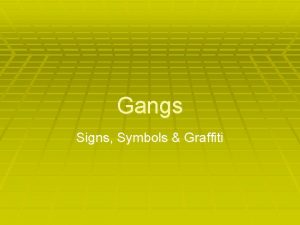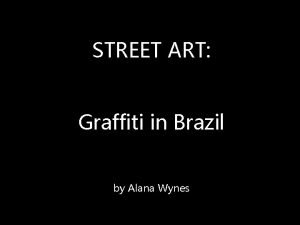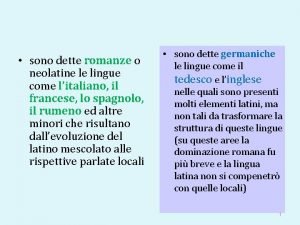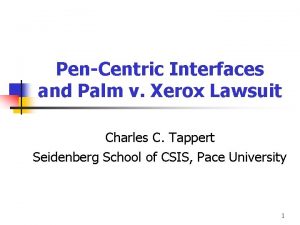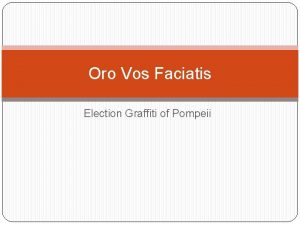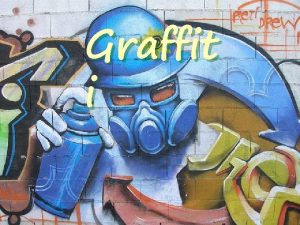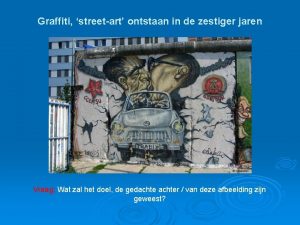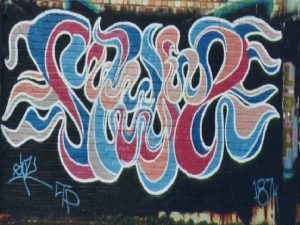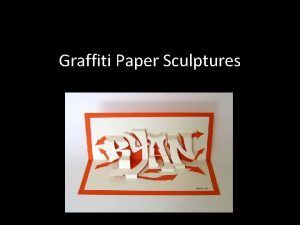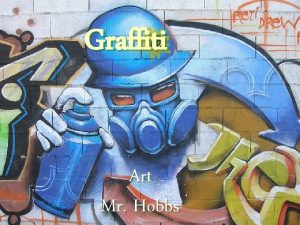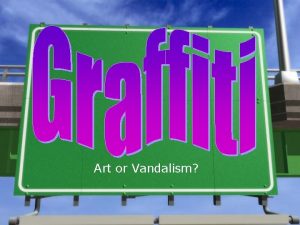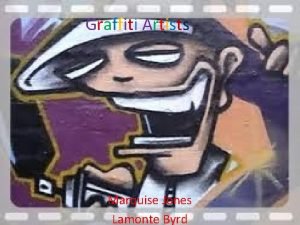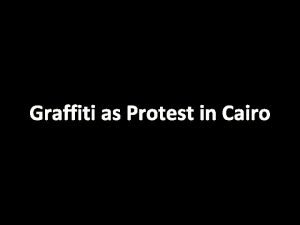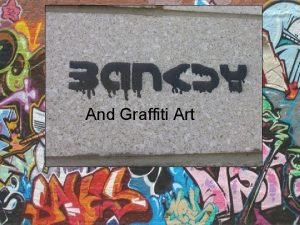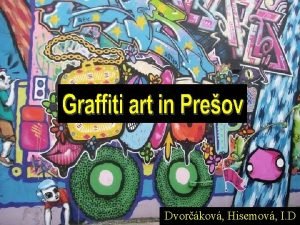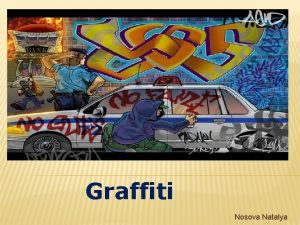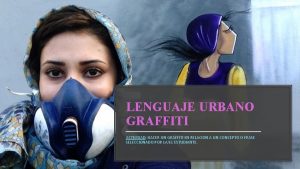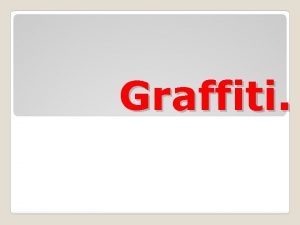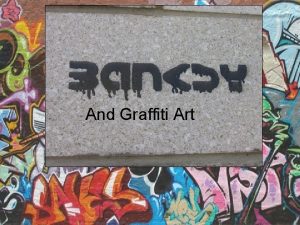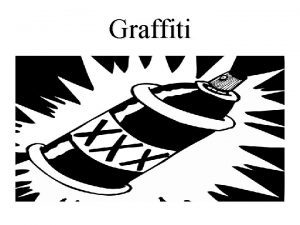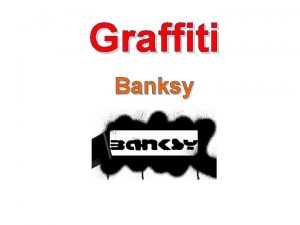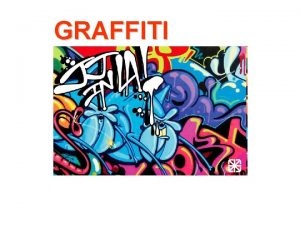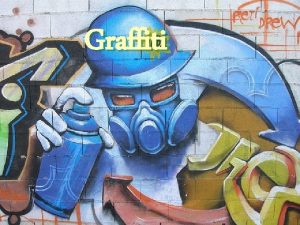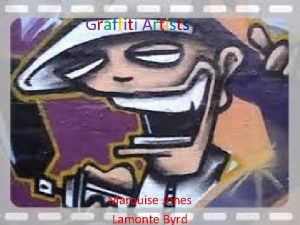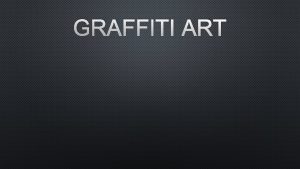History of Graffiti The word graffiti derives from






































- Slides: 38


History of Graffiti The word "graffiti" derives from the Greek word graphein meaning: to write. This evolved into the Latin word graffito. Graffiti is the plural form of graffito. Simply put, graffiti is a drawing, scribbling or writing on a flat surface. Today, we equate graffiti with the "New York" or "Hip Hop" style which emerged from New York City in the 1970's.


The Emergence of Hip Hop started in the inner city. It evolved from the rap music made in Brooklyn and Harlem in the late 1960's and early 1970's. Rap music was a reaction to the disco music of the period. Disco was centered in the rich clubs of Manhattan and rap emerged on street corners as an alternative. Using lyrical rhythms and 'beat boxing' the music was a way to express feelings about inner-city life. Hip hop emerged as turn tables began to be used to form part of the rhythm by `scratching' (the sound created by running the stylus over the grooves of an LP).


As Hip Hop music emerged so did a new outlet for artistic visibility. Keith Haring began using posters to place his uniquely drawn figures and characters in public places. Soon he began to draw directly on subway walls and transit posters. The uniqueness of his drawings eventually led to their being shown in galleries and published in books and his art became "legitimate".




Taki 183: Initiator of Tagging At about the same time as Keith Haring, a delivery messenger began writing "Taki 183" whenever he delivered documents. Soon his name was all over the city. Newspapers and magazines wrote articles about him and Keith Haring. Both became celebrities. This claim to fame attracted many young people, especially those involved with rapping. They began to imitate "Taki 183". Graffiti was part of the Hip Hop culture which also saw the start of rapping and break dancing. Breakdancing has since lost much of its initial popularity, while rapping has emerged as a major style in American music. New York City was inundated with graffiti during the late seventies and early eighties. But as media coverage faded so do did the graffiti. Then in the mid-eighties a national TV program did a graffiti story and set off a graffiti wildfire which really has become world-wide. . That’s the story of today’s graffiti….


Graffiti Culture Graffiti quickly became a social scene. Friends often form crews of vandals. One early crew wrote TAG as their crew name, an acronym for Tuff Artists Group. Tag has since come to mean both graffiti writing, 'tagging' and graffiti, a 'tag'. Crews often tag together, writing both the crew tag and their own personal tags. Graffiti has its own language with terms such as: piece, toy, wild-style, and racking.


Graffiti Tools At first pens and markers were used, but these were limited as to what types of surfaces they worked on so very quickly everyone was using spray paint. Spray paint could mark all types of surfaces and was quick and easy to use. The spray nozzles on the spray cans didn’t work so well to create the more colourful pieces. Caps from deodorant, insecticide, WD 40 and other aerosol cans were used instead to allow for a finer or thicker stream of paint. As councils began passing graffiti laws outlawing graffiti “ tools “ , clever ways of disguising paint implements were devised. Shoe polish, deodorant roll-ons and other seemingly innocent containers are emptied and filled with paint. Markers, art pens and grease pens obtained from art supply stores are also used. In fact nearly any object which can leave a mark on most surfaces are used by taggers, though the spray can is the medium of choice for most taggers.




In Britain we have a very active graffiti world and one of the most famous artists is Banksy, an urban terrorist who creates funny, thought provoking graffiti and images in very unusual places as well as on walls



Banksy is never seen , unless in disguise, and does not give interviews at all



August 2009: More than 300, 000 people have visited the Banksy exhibition in Bristol, it was revealed on the final day of the 12 -week art show. The Banksy Vs Bristol Museum exhibition saw people queuing for up to six hours to gain admission. Visitors to the free show have donated more than £ 45, 000 towards museum funds - roughly the amount usually collected across an entire year. On its last day people were queuing before dawn to see the exhibition. Banksy charged Bristol City Council £ 1 to stage the exhibition in his home town on condition all CCTV footage of him preparing the show was destroyed.




Of course, graffiti isn’t new, it has been found in Greek and Roman towns from 2, 000 years ago, the people who lived in caves drew on their walls before language existed….










 Espèce chimique naturelle exemple
Espèce chimique naturelle exemple Unité isoprénique
Unité isoprénique Who coined the term intertextuality in the 1960‘s
Who coined the term intertextuality in the 1960‘s Dérivés nitrés
Dérivés nitrés Produits dérivés du palmier à huile
Produits dérivés du palmier à huile In a bureaucracy a manager's formal authority derives from
In a bureaucracy a manager's formal authority derives from Origin of word graffiti
Origin of word graffiti Graffiti plural word
Graffiti plural word Light graffiti photography
Light graffiti photography Mga tanong tungkol sa heograpiya ng daigdig
Mga tanong tungkol sa heograpiya ng daigdig Where was graffiti originated
Where was graffiti originated Is graffiti art or crime
Is graffiti art or crime Common graffiti symbols
Common graffiti symbols Indefinite pronouns affirmative negative interrogative
Indefinite pronouns affirmative negative interrogative Natal brazil crime
Natal brazil crime Lingue romanze o neolatine
Lingue romanze o neolatine Graffiti uncountable
Graffiti uncountable Graffiti bilder
Graffiti bilder Blu graffiti
Blu graffiti Palm pilot graffiti alphabet
Palm pilot graffiti alphabet Marcus vesonius primus
Marcus vesonius primus Expectations graffiti
Expectations graffiti Milk graffiti
Milk graffiti Graffiti
Graffiti Alfabeti graffiti
Alfabeti graffiti Keith haring
Keith haring Hình ảnh bộ gõ cơ thể búng tay
Hình ảnh bộ gõ cơ thể búng tay Bổ thể
Bổ thể Tỉ lệ cơ thể trẻ em
Tỉ lệ cơ thể trẻ em Voi kéo gỗ như thế nào
Voi kéo gỗ như thế nào Tư thế worm breton là gì
Tư thế worm breton là gì Chúa sống lại
Chúa sống lại Môn thể thao bắt đầu bằng từ đua
Môn thể thao bắt đầu bằng từ đua Thế nào là hệ số cao nhất
Thế nào là hệ số cao nhất Các châu lục và đại dương trên thế giới
Các châu lục và đại dương trên thế giới Công của trọng lực
Công của trọng lực Trời xanh đây là của chúng ta thể thơ
Trời xanh đây là của chúng ta thể thơ Mật thư tọa độ 5x5
Mật thư tọa độ 5x5




